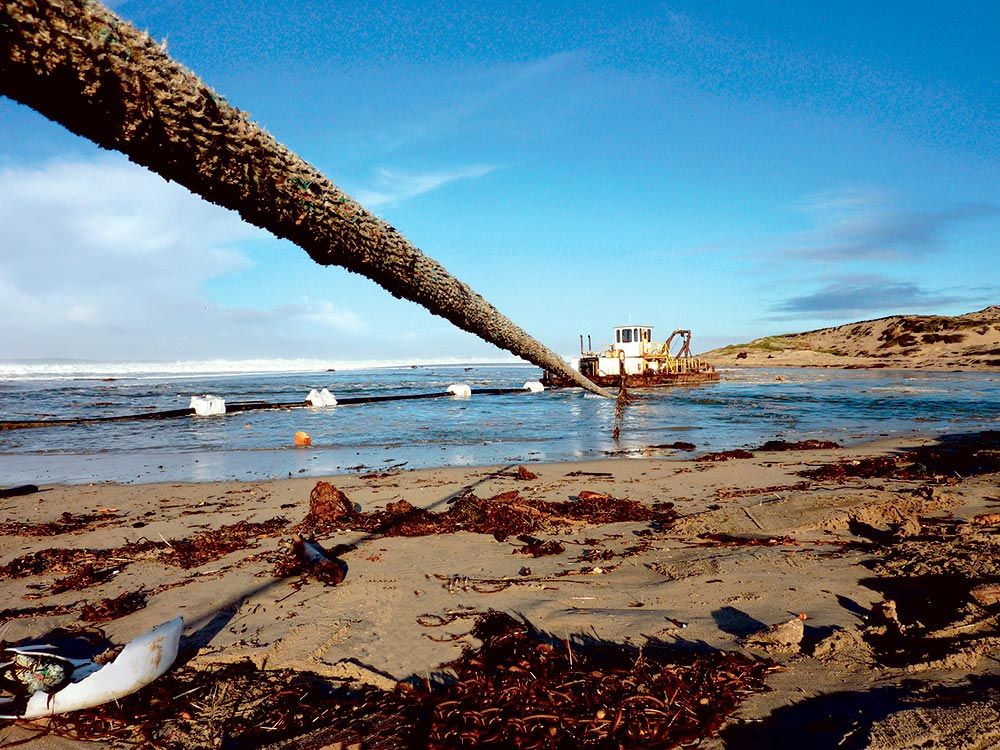Impact Locally: The Tourist Economy vs. the Consumptive Economy

The CEMEX sand mine located in Marina, CA, is the last coastal sand mine in the United States. It opened in 1906 in response to construction needs after the great San Francisco earthquake. When all other sand mines located in the Monterey Bay were closed in the 1990s (there had been a total of 6 operating in the bay), the CEMEX site eluded closure with a grandfather clause, and on the condition that their production level stay at the same historic levels. However, their sand production increased to eclipse the total of all five former mines, roughly 200-250,000 cubic yards of sand annually. That is a block of sand 10 feet high, 100 feet wide, and over 1 mile long annually. The beaches to the south, an economic generator and tourist draw for Monterey, are losing sand faster than anywhere else in the state, at exactly the same rate of the sand extraction by CEMEX.
What is the economic cost of this loss of sand to southern Monterey beaches? A 2012 student-generated study, “Lapis Sand Dollars,” estimated the loss at $1 million per year, however that number was an underestimate. The Center for the Blue Economy and Dr. Phil King, Economist at San Francisco State University, found in a 2016 study on the “Economic Impacts of Climate Adaptation Strategies for Southern Monterey Bay,” and another Dr. King did for NOAA in 2012, that the economic impact is closer to $8 million per year. “Please note that the recreational value here is what economists refer to as willingness to pay and not tourist spending. Either way the losses are staggering and close to $1 billion [over 10 years],” writes Dr. King in a 2016 correspondence.
In April of 2017, the Center for the Blue Economy wrote a letter to the California Coastal Commission and to each member of the State Lands Board, outlining the negative economic impacts of the mine. The letter writing campaign was part of a larger effort organized by Save Our Shores, a local environmental group that coordinated sending those same groups 3400 postcards from the public. This followed many years of activism and efforts from the community to bring this issue to the attention of the relevant agencies (2009 plea to CA Coastal Commission by scientist Ed Thornton to halt sand mine, 2010 NOAA study on sand loss). On May 16th, 2017, Lieutenant Governor Gavin Newson, Chair of the State Lands Board, issued a cease and desist order against the mine. The State Lands Board reached out to the Center for the Blue Economy to help outline the negative economic impacts of sand loss in their case against the mine.
However, legal action was not needed. In July of 2017, the California Coastal Commission unanimously agreed to settle with CEMEX, allowing them three years to end their sand extraction. In making public comment at the Coastal Commission meeting, scientist Ed Thornton, a long-time advocate to shut down the plant, estimated that beaches to the south should start to replenish at the rate of 1-1.5 feet per year. Although the state of California received little to no compensation for the public good taken from Monterey Bay shores for over a century, a three-year time frame to end the era of sand extraction is a fair compromise. It was a long battle, and the Center for the Blue Economy is glad to have played a part.
For More Information
This news article by David Schmalz, published on Jan. 16, 2016 in the Monterey County Weekly gives a nice overview of the history of the Cemex sand mine: Cemex Mine Reflects Human Hunger for Sand
Read the 2016 study: Economic Impacts of Climate Adaptation Strategies for Southern Monterey Bay
Read our student-generated 2012 policy paper: Lapis Sand Dollars
Watch the film Sand Wars for an understanding of how sand is consumed globally
